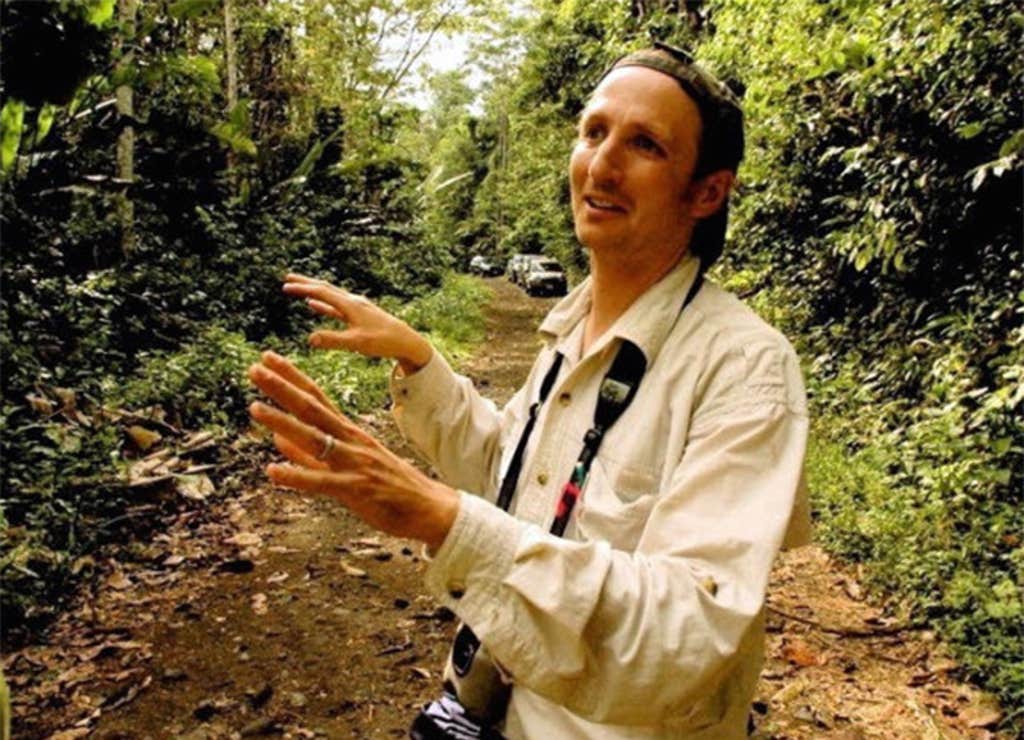In “On Exactitude in Science,” the short story writer Jorge Luis Borges wrote of an empire that achieved mastery in cartography. One map was so exacting, it was the size of the empire itself. Later generations found it so useless, Borges wrote, that they “delivered it up to the Inclemencies of Sun and Winters.”
In other words, they scrapped it. A map that precise, coinciding “point for point” with real territory, is ridiculously cumbersome. That level of exactitude may be extreme, but it offers an important reminder to scientists: Realistic models of the natural world can be counterproductive.
Brian Enquist, an evolutionary ecologist who studies plants at the University of Arizona and is an external professor at the Santa Fe Institute, likes the point Borges was making. He sees areas of science where an “exactitude culture” is too dominant. That includes his own field of biosphere science, which studies the interactions of all living things on the planet—the microbes, plants, and animals—and how they influence and are influenced by other dynamics, such as the atmosphere and climate change.

He’s the lead author of a recent paper published in the Proceedings of the National Academy of Sciences that makes the case for what he and his Santa Fe Institute colleagues call “scientific transculturalism.” It’s about integrating the three central different cultures of science—exactitude culture along with what the researchers call “variance culture” (which focuses on taking stock of how particular things are different or similar) and “coarse-grained culture” (which tries to simplify matters with general principles governing how systems operate).
There’s not enough “scientific transculturalism” in biosphere science, in particular, they argue. And that’s bad because to avert the worst impacts of climate disaster, we have to understand the interconnected systems of life to know what will happen when things change—and quickly. He coauthored the PNAS paper with Chris Kempes, an Earth systems theorist, and Geoffrey West, a physicist and author of Scale (excerpted in Nautilus).
He said his collaboration with Kempes and West was an example of scientific transculturalism in action—and not merely interdisciplinary science—because they each come from a different one of these cultures. Enquist says he’s been “dragged kicking and screaming to do more of a coarse-grained approach,” which is where West feels at home; whereas Kempes gets deep into precision modeling, using artificial intelligence to create simulations of Earth’s systems. But they hope their work together on this paper can itself be a model for these sorts of collaborations.
We caught up with Enquist, a measured and careful talker, while he was traveling.
What makes understanding the biosphere—all of life’s intricate interactions on Earth—so daunting?
It’s daunting for a number of reasons. The biosphere is just mind-bogglingly complex. Biological processes operate at the cellular level as well as all the way up to ecosystems and larger. The biosphere is coupled to the overall Earth system—what’s happening with the water system, the atmosphere, the oceans, and so on.
It’s also complicated because the drivers and the stressors on the biosphere are coming from many different sources. We have changes in the overall climate. We have human-related pressures—human land-use changes associated with everything from agriculture to increasing urbanization, overfishing and overhunting. These different pressures add up independently. There’s also a lot of nonlinearities—a lot of aspects of those interactions that are unexpected.
Darwin practiced each of those different cultures.
All that complexity doesn’t totally explain why predicting what will happen in the biosphere is so challenging. You say there’s also this problem of different cultures in science that aren’t working well together, making progress more difficult.
Right. We started coming to the realization that there are three different cultures or approaches to how one does science.
Can you explain a little more about these “cultures?”
One is variance culture. The variance culture is focused on understanding the diversity of different entities and processes in a system.
Another one is coarse-grain culture. You can think of that as how a physicist might view the world, where one approaches the world based on trying to distill simplicity from complexity.
The last is exactitude culture, which is focused more on trying to understand all the intricate details and connections associated with effectively mapping out all possible kinds of interactions among entities within the system.
Each of these different cultures have positives and negatives, especially if they’re only operating by themselves. But these positives and negatives can augment and accelerate each of the different attributes of the cultures when they’re all working together. We argue the result is more rapid scientific insight and knowledge.
How do these different cultures look in a particular field—like your main field of plant ecology?
If I’m operating strictly in variance culture, I would be doing something like natural history. When I go out, I record all these different plants that I see in a given location. I note how they may be similar and different from each other. Variance culture focuses you on maybe collecting new species, identifying novelties, like a new range extension, or tracking very rare and endangered species. Variance culture has given us a lot of what we know about the natural world, for example in terms of identifying species more prone to extinction.
The exactitude culture, in the spirit of Jorge Luis Borges’ short story, would be shifting to more of a modeling framework: Let’s map out the abundances of all of these different species and all of their byzantine interactions and processes. We’ll ask questions, such as, what maintains all of this diversity? We’ll maybe start thinking about differences in predation that may negatively influence one species, but may positively influence another species. Maybe we would create a very complicated simulation model.
In coarse-grain culture, somebody more trained in the physical sciences would step back and say, “This is a very complicated system. Maybe we can take an analytical approach and write down the main state equations that may be governing a key dynamic of the system that you’re interested in.” Maybe it’s species diversity. That person would say let’s simplify this. Maybe the main drivers on what influences the total diversity of the system could be just temperature. If you warm up the planet, maybe you speed up biological processes. If temperature has a positive effect on immigration rates, but a negative effect on extinction rates, we would derive equations based on those assumptions of what our projected extinction risk may be. Then it’s also how habitat area influences species diversity. We add that to our temperature models. And out would pop a model predicting species diversity as a function of those variables. So it’s this stepping back from the details.
But these cultures aren’t working together in our efforts to understand the dynamics of life on our planet?
We are stuck in either a more variance or exactitude culture, or an integration of the two, at the expense of coarse-grain culture. There are efforts to do more of a coarse-grained approach to the biosphere, but they definitely need to be informed by the variance and the exactitude cultures. In the past, when those cultures operated together, we saw rapid developments in biology, as well as in the other sciences.
As models get more complicated, they become their own ecosystems.
Are there any areas of science these days that are integrating these cultures well?
It seems that the atmospheric sciences, and other Earth sciences, have each of the different cultures integrated and working together.
Within the atmospheric sciences, the coarse-grain culture has helped forge ahead with the more simplified, bare bones models for how changes in fossil fuels—CO2 in particular—influence the temperature on the planet. The exactitude culture takes the simplified models and applies them to different spatial scales, looking to see where those simplified predictions are wrong, then improving them by putting in details like high and low atmospheric pressure. When you add those things, you can start making more detailed predictions, based on the variance culture, knowing how differences in water vapor and humidity and snowfall and clouds, influence the temperature variation on the planet. You can start to model in more detail, where you have all three of those different inputs operating together.
Then you have our enormously successful climate models on the Earth, where we can project fine-scale variation in temperature and precipitation change across the entire planet, under different climate-change scenarios, not only a decade or two from now, but also, 100-plus years into the future. They also run them backward, to back-predict or hindcast past climates. It’s an enormous success.
Would it be right to say Charles Darwin practiced all three cultures in his scientific career?
Yes, he did, even though he didn’t write down any equations, or even diagrams, for the theory of evolution by natural selection. But if you look through all of his writings, he actually practiced each of those different cultures. Darwin searched for the generalities that cut across all of life. He identified that if you take exponential population growth and the fact of finite resources, then not all individuals can survive. Some survive because they’re better at competing for resources and have higher reproductive output, hence, fitness. The end result is natural selection. It’s brilliant, simple. It’s built on—and refined from—his understanding of natural history. He also loved mapping out all the details. By iteration between the different cultures, he was able to refine the overall theory.
You call the effort to unify these cultures “scientific transculturalism.” How is this different from efforts to make science more interdisciplinary? Hasn’t that been an emphasis in science for years now?
It’s very different from interdisciplinary science. Transculturalism isn’t just about combining expertise from different disciplines but is about merging the underlying philosophies and approaches into a cohesive framework. In interdisciplinary science, you’re bringing together an economist and an ecologist. Or you’re bringing together a social scientist with somebody who does conservation biology. But just because you bring in people from different disciplines doesn’t mean that they’re coming from different scientific cultures.
They could all be from a variance or a coarse-grain culture.
Right. Which is fine. When you have people from the same scientific culture talking to each other, good things will likely happen. But if you really want to develop what we think are the deeper understandings—the solutions that would enable you to develop more of a predictive science—that requires the integration of these different cultures.
You say it can be counterproductive to make models of our biosphere increasingly realistic. But aren’t more realistic models more useful?
Well, it can certainly seem like that, right? There are a number of issues that pop up. I would point you to Borges’ short story. We add more variables and components to our models, say the role of light and how that influences forest growth. We start to get very detailed, which is good, because it helps solidify our understanding of the complexities.
But what tends to happen is that as the model gets more complicated, it gets harder to see what’s driving the predictions you’re able to make. You don’t know whether or not it’s associated with the uncertainties of your measurements or ones associated with the structure of your complicated model.
As models get more complicated, errors and interactions propagate in weird ways. As they get more complicated, it’s actually much more difficult to understand them. They become their own ecosystems in a way. This is not a joke. There are now journals associated with the study of very complicated biosphere models, the ecology of the complex model, instead of understanding the natural world that we want to model.
What do you recommend scientists do to reboot scientific transculturalism?
It’s important to just recognize which culture or cultures one feels most comfortable with. It’s also key to help students understand that these different approaches to tackling very complicated problems exist—and that how you approach a problem has positive and negative attributes. Biology departments in particular should foster a culture of closely integrated coarse-grained thinking with detailed observations and specific models. In order to tackle grand challenges that society faces, it’s not enough just to do interdisciplinary science. ![]()
Lead image: topvector / Shutterstock
-
Brian Gallagher
Posted on May 14, 2024
Brian Gallagher is an associate editor at Nautilus. Follow him on X (formerly known as Twitter) @bsgallagher.
Get the Nautilus newsletter
Cutting-edge science, unraveled by the very brightest living thinkers.
Discover more from CaveNews Times
Subscribe to get the latest posts sent to your email.


























![Exploring the Serene Beauty of Nature: A Reflection on [YouTube video title]](https://cavemangardens.art/storage/2024/04/114803-exploring-the-serene-beauty-of-nature-a-reflection-on-youtube-video-title-360x180.jpg)


























